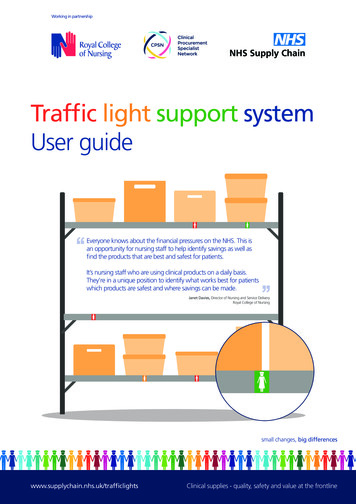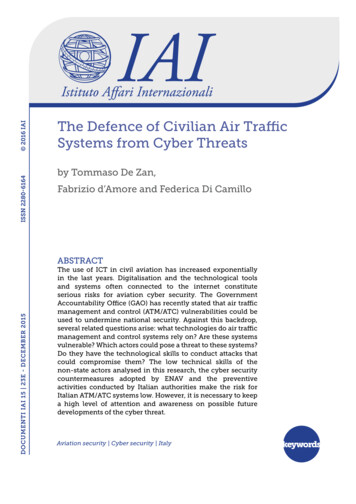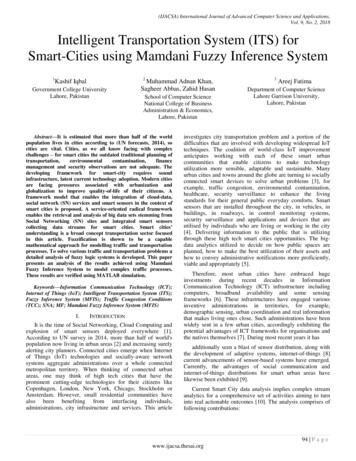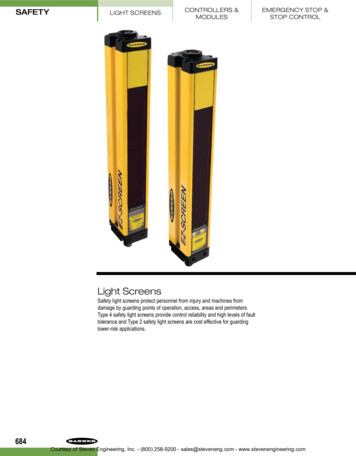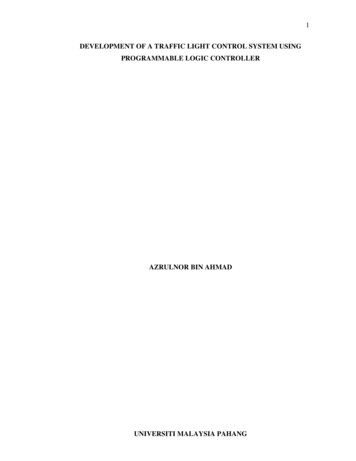
Transcription
1DEVELOPMENT OF A TRAFFIC LIGHT CONTROL SYSTEM USINGPROGRAMMABLE LOGIC CONTROLLERAZRULNOR BIN AHMADUNIVERSITI MALAYSIA PAHANG
VABSTRACTDevelopment of a traffic light control system using PLC (ProgrammableLogic Controller) is the title of this project. This project is divided into two partswhich are hardware and software. The hardware part for this project is a model offour way junction of a traffic light. Each lane has two limits switch (input) functionas a sensor. Three indicator lamps with different colours (Red, Yellow and Green)are installed at each lane for represents as traffic light signal. This limit switches andindicator lamps are connected to Omron PLC CQM1H-CPU51. The PLC controlsevery signal which is coming from the inputs (Limit switch) to software and displayto the outputs (Indicator lamps). The software part operates with Omron PLC is CXProgrammer. With using this software, the ladder logic diagram is programmed tocontrol the traffic light base on the flow chart. At the end of this project, the trafficlight successfully control by PLC.
1CHAPTER 1INTRODUCTION1.1Overview of traffic light systemEver since Roman times, society has tried to control traffic. Even the fabledRoman road system created a conflict between pedestrian and equine travelers.However, a practical solution was not developed until the mid-nineteenth century,when J. P. Knight, a railway signaling engineer, created the first traffic signal, whichwas installed near Westminster Abbey in London, England in 1868. Unfortunately,the device exploded, killing a police officer, and its use was discontinued after beingin operation for only a short time.The modern traffic light was invented in America. New York had a threecolor system in 1918 that was operated manually from a tower in the middle of thestreet. Other cities soon adopted the idea of having someone on the scene to controlthe lights. Garrett Morgan, inventor of the gas mask, also developed traffic signalingdevices. Having witnessed an accident between a car and a carriage, Morgan feltcompelled to devise a system to prevent such collisions at street intersections. In1923 he patented an electric traffic light system using a pole with a cross section onwhich the words STOP and GO were illuminated.
2These basic designs were soon improved. In 1926 the first automatic signalswere installed in London; they depended on a timer to activate them. In the 1930svehicle-activated lights were created in which cars rolled over half-buried rubbertubes. Air in the tubes was displaced by the weight of the car rolling over them, andthe increased pressure operated an electric contact, activating the lights. But thesetubes wore out quickly. A better idea was the inductive-loop device: a loop of wirewas imbedded in the road itself and connected to a box controlling the lights; acurrent of electricity passed through the loop, and when the steel body of a carpassed overhead, it produced a signal that activated the light.Today, traffic is automatically routed onto limited access highways courtesyof a computer activated guidance system that determines traffic volume on thehighway. Global positioning satellite systems (GPS) are installed in many cars.These systems connect with a satellite and inform drivers where they are andpossible routes to their destination. Such systems will eventually enable a drive todetermine the best route to a destination given prevailing traffic conditions.1.2Overview of Programmable logic controller (PLC)A programmable logic controller (PLC) is an industrial computer used tocontrol and automate complex systems. Programmable logic controllers are arelatively recent development in process control technology. It is designed for use inan industrial environment, which uses a programmable memory for the integralstorage of user-oriented instructions for implementing specific functions such aslogic, sequencing, timing, counting, and arithmetic to control through digital oranalog inputs and outputs, various types of machines or processes.
3Programmable logic controllers are used throughout industry to control andmonitor a wide range of machines and other movable components and systems. PLCis used to monitor input signals from a variety of input points (input sensors) whichreport events and conditions occurring in a controlled process. Programmable logiccontrollers are typically found in factory type settings. PLCs are used to controlrobots, assembly lines and various other applications that require a large amount ofdata monitoring and control.A typical programmable logic controller employs a backplane to serve as thecommunications bus for interconnecting the PLC processor with the array ofindividual input/output devices with which the processor interacts in terms ofreceiving input data for use in executing the control program and transmittingcontrol data for use in controlling the targeted objects. A PLC includes a rack intowhich a plurality of input/output cards may be placed. A rack includes several slotsinto which these input/output cards are installed.Each input/output card has a plurality of I/O points. The I/O modules aretypically pluggable into respective slots located on a backplane board in the PLC.An I/O bus couples the cards in the slots back to the processor of the programmablelogic controller. The slots are coupled together by a main bus which couples any I/Omodules plugged into the slots to a central processing unit (CPU).The CPU itself can be located on a card which is pluggable into a dedicatedslot on the backplane of the PLC. The particular processor employed in a PLCtogether with the particular choice of input and output cards installed in the PLCrack are often referred to as the hardware configuration of the programmable logiccontroller. The hardware configuration also includes the particular addresses whichthe I/O cards. Each option module typically has a plurality of input/output points.
4The option modules are coupled through an interface bus, for example via abackplane, to a main controller having a microprocessor executing a user program.Option modules may also include a microprocessor and a memory containingseparate user programs and data directed to a particular operation of the PLCsystem. During the execution of a stored control program, the PLC's read inputsfrom the controlled process and, per the logic of the control program, provideoutputs to the controlled process. The outputs typically provide analog or binaryvoltages or "contacts" implemented by solid state switching devices.PLC's are normally constructed in modular fashion to allow them to be easilyreconfigured to meet the demands of the particular process being controlled. Theprocessor and I/O circuitry are normally constructed as separate modules that maybe inserted in a chassis and connected together through a common backplane usingpermanent or releasable electrical connectors.1.3Project objectivesThis project is about develop a new practical traffic light control systemwhich the system will solve the traffic congestion issue. To develop the project,there are two objectives that must be accomplished which are:-i. Develop a new traffic light control system controlled by programmable logiccontroller (PLC).ii. Implement the system on a model of a traffic light.
51.4Project scopei.Construct a model of four way junction of a traffic light model.ii.Programmed a ladder logic diagram to control the traffic light.iii.Combine the software part and the hardware part to simulate a traffic lightsystem.1.5Problem statementThe monitoring and control of city traffic light is becoming a major problemin many countries. The increasing number of vehicles and the lower phase ofhighways developments have led to traffic congestion problem especially in majorcities such as Kuala Lumpur, Georgetown, Johor Bahru, and Ipoh. Travel time,environment quality, life quality, and road safety are all adversely affected as aresult of traffic congestions. In addition, delays due to traffic congestions alsoindirectly affect productivity, efficiency, and energy losses.There are many factors that lead to traffic congestion such as the density ofvehicles on the roads, human habits, social behavior, and traffic light system. Onemajor factor is due to the traffic lights system that controls the traffic at junction.Traffic policeman are deployed at traffic intersection everyday in order to overcomethese congestion during peak hour, thus one of the roots of the problem is due toineffective traffic lights controllers. With effective control the intersection, it is
6believed that the overall capacity and performance of urban traffic network could beresolve.There are several types of conventional methods of traffic light control;however they fail to deal effectively with complex and time varying trafficconditions. Currently, two types of traffic light control are commonly installed inMalaysia and many parts of the world: the preset cycle time (PCT) and vehicleactuated (VA). Due the deployment of a large number of traffic police in the cityduring peak hours, it is evident that these types of traffic lights controllers areinadequate. There is a need to research on new types of highly effective practicaltraffic light controllers.In this paper, the proposed of a new development of a traffic light controlsystem controlled by PLC. This system will decreased the traffic congestion attraffic light by extend the time for the green signal if traffic density at that lane arehigh and give the priority to who first arrive at the junction to get a green signal.1.6Thesis outlineChapter 1 is introduction to programmable logic controller and traffic lightsystem. This chapter also explains about project objectives and scopes and discussabout problem statement.Chapter 2 focuses on hardware development and configuration. This chapterexplains every detail about PLC Omron CQM1H and traffic light model. The wiringdiagram for this hardware also will be discussed in this chapter
7Chapter 3 deals with the software development using software CXProgrammer. These chapters also discuss the flowchart and development programfor traffic light system.Chapter 4 presents all the results obtained and the configuration of doingsimulation in the real world.Chapter 5 discusses the conclusion of this project development traffic lightcontrol system using Programmable Logic Controller. This chapter also explains theproblem and the recommendation for this project and for the future development orsystem modification.
8CHAPTER 2SYSTEM HARDWARE2.1IntroductionThe hardware part of this project is Programmable logic controller (PLC) anda traffic light model. Omron CQM1H-CPU51 is the type of PLC used in this projectas the processor to control the traffic light. This type of PLC was been chosenbecause the characteristic is fully necessary by the development of traffic lightsystem.The four ways traffic light model is constructed to display how this trafficlight control system is running. This traffic light model has a complete set of trafficlight signal which are red, yellow and green as a traffic signal for each lane. Eachlane also has two limit switches represent as a sensor on the road. The first sensorplaced in front of the lane to detect the presence of a car at the junction and thesecond sensor placed at certain length from first sensor to determine the volume ofcar at that lane. The right connection between PLC and traffic light model is veryimportant because it can avoid the problem or conflict when the program istransferred to PLC.
92.2Programmable Logic Controller2.2.1PLC configurationi.Many PLC configurations are available, even from a single vendor. But eachof these has common components and concepts. The most essentialcomponent is are:ii.iPower supply – This can be built into the PLC or be an external unit.Common voltage levels required by the PLC are 24Vdc 120Vac 220Vac.iii.CPU (central Processing Unit) – This is a computer where ladder logic isstored and processed.iv.I/O (Input/output) – A number of input/output terminals must be provided sothat the PLC can monitor the process and initiate actions. Inputs to, andoutputs from, a PLC is necessary to monitor and control a process. Bothinputs and outputs can be categorized into two basic types: logical orcontinuous. Consider the example of a light bulb. If it can only be turned onor off, it is logical control. If the light can be dimmed to different levels, it iscontinuous.v.Indicator lights – These indicate the status of the PLC including power on,program running, and a fault. These are essential when diagnosing problems.vi.Rack Type : A rack can often be as large as 18” by 30” by 10”
10vii.Mini: These are similar in function to PLC racks, but about the half size.Dedicated Backplanes can be used to support the cards OR DIN railmountable with incorporated I/O bus in module.viii.Shoebox: A compact, all-in-one unit that has limited expansion capabilities.Lower cost and compactness make these ideal for small applications. DINrail mountable.ix.Micro: These units can be as small as a deck of cards. They tend to havefixed quantities of I/O and limited abilities, but costs will be lowest. DIN railmountable
112.2.2Basic PLC schemaThe basic PLC schema include CPU, power supply, memory, Input block, outputblock, communication and expansion connections. Figure 2.1 shows the PLC systemoverview.Figure 2.1 PLC system overviewCPU modules - The Central Processing Unit (CPU) Module is the brain ofthe PLC.Primary role to read inputs, execute the control program, update outputs.The CPU consists of the arithmetic logic unit (ALU), timing/control circuitry,accumulator, scratch pad memory, program counter, address stack and instructionregister. A PLC works by continually scanning a program.Memory - The memory includes pre-programmed ROM memory containingthe PLC’s operating system, driver programs and application programs and theRAM memory. PLC manufacturer offer various types of retentive memory to saveuser programs and data while power is removed, so that the PLC can resume
12execution of the user-written control program as soon as power is restored. Sometypes of memory used in a PLC include:i.ROM (Read-Only Memory)ii.RAM (Random Access Memory)iii.PROM (Programmable Read-Only Memory)iv.EPROM (Erasable Programmable Read-Only Memory)v.EEPROM (Electronically Erasable Programmable Read-Only Memory)vi.FLASH Memoryvii.Compact Flash – Can store complete program information, read & write textfilesviii.I/O Modules - Input and output (I/O) modules connect the PLC to sensorsand actuators. Provide isolation for the low-voltage, low-current signals thatthe PLC uses internally from the higher-power electrical circuits required bymost sensors and actuators. Wide range of I/O modules available including:digital (logical) I/O modules and analogue (continuous) I/O modules.
132.2.3PLC OperationCHECK INPUT STATUS-First the PLC takes a look at each input todetermine whether it is on or off condition.EXECUTE PROGRAM-Next the PLC executes a program by oneinstruction at a time. If the first input is on then it should turn on the first output.Since it already knows then it will be able to decide whether the first output shouldbe turned on based on the state of the first input. It will store the execution resultsfor use later during the next step.UPDATE OUTPUT STATUS-Finally the PLC updates the status of theoutputs. It updates the outputs based on which inputs are on during the first step andthe results of executing your program during the second step. Based on the examplein step 2 it would now turn “ON” the first output because the first input is “ON” andyour program said to turn “ON” the first output when this condition is true.Figure 2.2PLC operation block diagram
142.2.4Internal PLCINPUT RELAYS-(contacts) These are connected to the outside world. Theyphysically exist and receive signals from switches, sensors, etc.INTERNAL UTILITY RELAYS-(contacts) These do not receive signalsfrom the outside world nor do they physically exist. They are simulated relays andare what enables a PLC to eliminate external relays.OUTPUT RELAYS-(coils) These are connected to the outside world. Theyphysically exist and send on/off signals to solenoids, lights, etc.DATA STORAGE -Typically there are registers assigned to simply storedata. They are usually used as temporary storage for math or data manipulation.They can also typically be used to store data when power is removed from the PLC.2.3CQM1H configurationFigure 2.3 shows the Omron PLC CQM1H configuration. The main body ofthis PLC is power supply unit, Central processor unit and input/output slot. Thepower supply unit receive the required PLC voltage is 240Vac. For safety thevoltage to PLC must connect to automatic circuit breaker before connect to the PLCbecause to protect the PLC from overload. The CPU covered by Analog input/outputslot, RS232 port, and processor. The inputs/outputs slot uses for system are usingdigital input and digital output. There are not limited slot for input and output portand can use for multiple inputs/outputs card.
15Figure 2.3 CQM1H configuration2.4Traffic light modelThe four ways junction is developed to display the simulation thedevelopment of the new traffic light control system. Figure 2.4 and 2.5 show thedesign of traffic light model. Every lane and traffic light signals have been labeledwith alphabet A, B, C and D to separate each lane and traffic light. Each traffic lightlane has their set of traffic light signal “Red, Yellow, and Green”. This traffic lightsignal operates similar like common traffic light signal. It changes from red to greenand then yellow and after that back to red signal.
16Each lane also has two limit switches represent as a sensor on the road. Thesuitable sensor for design a real traffic light system is type of linear sensor orelectromagnetic sensor. The first sensor placed in front of lane to detect the presencecar at the junction and the second sensor placed at certain length from first sensor todetermine the volume of the car at that lane. From this combination of sensor, wewill know the expected time for green signal on when each lane change to the greensignal.Figure 2.4 Traffic light model
17Figure 2.5 Traffic light hardware2.5Hardware wiring diagramOnce hardware is designed ladder diagrams are constructed to document thewiring. For this project, existed PLC cabinet box are use and connect with the trafficlight model. A basic wiring diagram is as shown in figure 2.6. The PLC would besupplied with AC power 240V and then I/O card supplied with DC power 12V to24V. The common for input card is 24Vdc and for output card is 0Vdc. A fuse isused after disconnect to limit the maximum current drawn by the system.
18Figure 2.6 PLC cabinet box wiring diagram.The PLC input wiring address start with number 0.00 to 0.15 for every inputcard. When the other input card is install to the PLC socket the address for this inputcard will start with number 1.00 to 1.15 and so on. Figure 2.7 shows the wiringdiagram for input card which this input card connects to sensor (limit switch) attraffic light model.
19Figure 2.7 Input wiring diagramThe PLC outputs wiring address start with number 100.00 to 100.07 forevery output card. When the other output card is install to the PLC socket theaddress for this output card will start with number 101.00 to 101.07 and so on. Thefigure 2.8 show the wiring diagram for output card which output card connect tosensor (limit switch) at traffic light model.
20Figure 2.8 Output wiring diagram
21CHAPTER 3SYSTEM SOFTWARE3.1Introduction to CX-Programmer softwareCX-Programmer is a PLC programming tool for the creation, testing andmaintenance of programs associated with Omron CSI-series PLCs, CV-series PLCsand C-series PLCs. It provides facilities for support of PLC device and addressinformation and for communications with OMRON PLCs and their supportednetworkCX-Programmer operates on IBM compatible personal computers withPentium or better central processors, including Pentium II. It run in a Microsoftwindows environment. The information within a CX-Programmer project consists ofladder programs, operands, required PLC memory content, I/O table, expansioninstructions (if applicable) and symbols. Each CX-Programmer project file isseparate and is a single document.
22CX-Programmer can only open a single project at a time. However, it ispossible to deal with many project files by using CX-Programmer at once. A CXProgrammer project has a CXP or CXT file extension (normally the CXP file is usedand is a compressed version of the CXT file).3.2Diagram workspaceThe diagram workspace can display a ladder program, the symbol table ofthat program or the Mnemonic view. The details displayed depend upon theselection made in the project workspace.When a new project is created or a new PLC added to a project, an emptyladder is automatically displayed on the right-hand side to the project workspace.The symbol table and Mnemonics view must be explicitly selected to be displayed.All views can be opened at the same time and can selected via option associatedwith the window menu.PLC program instruction can be entered as a graphical representation inladder form. Programs can be created, edited, and monitored in this view. The 3.1shows the diagram workspace appearance.
23Figure 3.1 Programming section3.3Program development.Before construct a ladder logic diagram, program flowchart is ideal for aprocess that has sequential process steps. The steps will be executed in a simpleorder that may change as the result of some simple decisions. The block symbol isconnected using arrow to indicate the sequence of the steps and different types ofprogram actions. The other functions may be used but are not necessary for mostPLC applications.A flowchart in figure 3.2 shows about how the lane changes to the other lanefor a green signal. This traffic light system is working independently to change fromone lane to the other lane based on which lane can activate sensor 1 fast. This trafficlight system give the priority to the lane which have a car and followed by the other.
24This traffic light control system operate similar to intelligent traffic light systemwhich it only give a green signal to the lane which have a vehicles and not like acommon traffic light control system which have a fix rotation for each lane.Figure 3.2 Traffic phase flowchartFigure 3.3 shows a sample ladder logic diagram that has been constructed forthe flowchart is shown in figure for the lane A. The ladder diagram for the otherlanes is similar with this ladder diagram but the memories for the contacts aredifferent.
to the outputs (Indicator lamps). The software part operates with Omron PLC is CX-Programmer. With using this software, the ladder logic diagram is programmed to control the traffic light base on the flow chart. At the end of this project, the traffic lig


